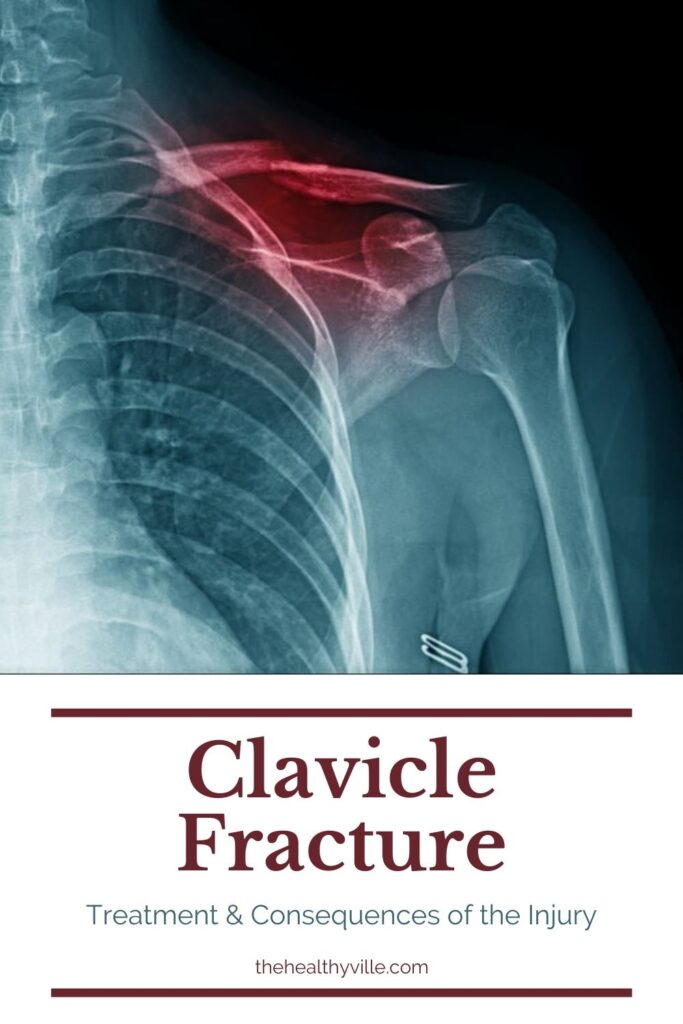Clavicle fracture treatment must be a proper one, even though regardless of it, there are consequences of the injury. Find out more about it!
The clavicle fracture is one of the most common in the body. It is associated with falls and blows on the shoulder. In addition, it is more common in young people.
The clavicle fracture is one of the most common bone injuries. It consists of the partial or total breakage of said bone that is in the upper part of the thorax. It is essential to be able to move the arm properly.
The clavicle fracture is very common in traffic accidents and in certain sports, such as motorcycling. The problem is that, if you cannot treat it well, it can lead to a number of complications. Therefore, in this article we explain everything you need to know about the injury and how it is treated.
What is a clavicle fracture?
The clavicle is an S-shaped bone that connects the breastbone to the shoulder blade. That is, it joins the shoulder with the trunk, making the movement of the arm possible. We have two clavicles: one left and one right.
Numerous vital structures run near this bone. For example, the subclavian and axillary vessels or the brachial plexus, which is made up of all the nerves that allow mobility and sensitivity of the upper extremities.
As Cochrane specialists explain, clavicle fracture is one of the most common types of bone breakage. Specifically, it tends to fracture in the middle third. The highest incidence occurs in young adults and children.
Why does it occur?
Clavicle fracture can occur for many reasons. The main mechanism is falls in which there is direct trauma to the shoulder. It is also common in those in which the outstretched hand falls and the impact is transmitted to this area.
Another common cause is traffic accidents. It is an injury that is usually found in motorcyclists and cyclists, although it can also appear in car drivers. In the same way, it can be associated with a sporting activity, since falls are common in sports such as football or rugby.
An article published in Progress in Obstetrics and Gynecology explains that clavicle fracture is also common in newborns. It can occur during childbirth, especially in those in which the child has an inappropriate position or is large.
The reason that this injury has a higher incidence in young people is that this bone does not fully harden until after the age of 20. That is why it is more fragile in the event of any trauma.
Symptoms
The clavicle fracture usually produces quite obvious symptoms. The main sign is pain, which increases when trying to mobilize the arm or shoulder. In addition, it can be accompanied by a clicking sound or inability to mobilize.
The fracture may cause the bone to shift and a lump to appear. Above all, it usually occurs when the injury is at the end of the clavicle. Tenderness, bruising, and swelling are also common.
A doctor should always examine this injury. Therefore, before any blow or fall that causes these signs, it is essential to consult. In babies, it is rare for the fracture to go unnoticed.
However, if it is observed that a baby has the arm extended continuously or does not move it during the first days of life, it is necessary to see a doctor urgently.
How to diagnose it?
To diagnose a clavicle fracture it is essential to take a correct medical history. The patient must tell if there has been a history of trauma or fall.
A small lump or swelling may be seen along the collarbone. In some cases, the bone can move through the skin, resulting in an open wound.
The complementary test that is most used to aid diagnosis is radiography. With it, the fracture line and the arrangement of the bones can be observed. However, in some cases, other more specific studies may be necessary, such as computed tomography.
Clavicle fracture treatment
The clavicle fracture treatment depends on the characteristics of the injury and the patient’s conditions. An open or displaced fracture often requires a more complex approach. We explain the different options.
Non-surgical
When the fracture is closed and the bones have barely moved from their original position, the injury can be treated conservatively. Most of them heal on their own by immobilizing the arm for a period of time.
According to the specialists from the Mayo Clinic, the immobilization time varies depending on age and severity. Children usually heal before 6 weeks, while adults may require 3 months.
Conservative treatment also includes medications to relieve inflammation and pain. The most recommended are non-steroidal anti-inflammatory drugs.
Surgical
Sometimes the clavicle fracture is open or the fragments are displaced. In these cases, surgical treatment is usually necessary. It is also recommended if the clavicle has been broken into more than two pieces.
The surgery consists of fixing the fragments using plates or screws. In this way, the bone heals more quickly and the possibility of it being in the wrong position reduces.
Complications
A clavicle fracture can cause complications, both in the short and long term. One of the main ones is the injury of neighboring structures by some of the bone fragments. For example, there can be damage on the nerves of the brachial plexus, causing paralysis. This is common in babies.
Another complication is osteoarthritis. It is a pathology that consists of the wear of the cartilage that forms the joint. A bony bulge may also appear in the bone as a result of the fracture healing process.
Surgery also comes with risks of infection and poor healing. Especially in cases where the fracture is severe, either because there are many fragments or because they are widely displaced.
Recovery from this injury
To avoid complications from a broken collarbone, it is essential to follow your doctors’ instructions on recovery. The indicated immobilization time and the way to do it must be met.
In addition, recommendations are to apply cold compresses in the area the first days. This helps to reduce inflammation and, with it, pain. Similarly, another of the pillars is physiotherapy. The idea is to gradually mobilize the joint to regain strength and flexibility.
Remember that clavicle fracture is very common
The clavicle is one of the bones that most often gets a fracture. The injury can occur from a fall, a blow to the shoulder, or even during birth.
Immobilization for treatment can be complex to comply with, but it is essential to avoid complications. In many cases, the bone does not heal properly and osteoarthritis or bone malformations appear. That is why medical indications should always be followed.
Read more: What Causes Neck and Shoulder Pain and How to Stop It?
Don’t forget to SHARE all about the clavicle fracture treatment and consequences with your friends and family on your social networks!

